 Facebook
Facebook
 X
X
 Instagram
Instagram
 TikTok
TikTok
 Youtube
Youtube

Bernie Sanders attracts big campaign crowds with his authenticity and populism - but this unique candidate has met his match in unorthodox Alexander Tschäppät, Switzerland’s outspoken rabble-rouser.
Sanders is a Vermont Senator; Tschäppät has served in the Swiss parliament’s lower house. Sanders is a democratic socialist, Tschäppät belongs to Switzerland’s Social Democratic Party. Sanders rails against Wall Street, calls for breaking up big banks and taxing speculators, and champions the middle class.
Not to be outdone, in a 2015 May Day speech Tschäppät denounced “those who live off share trading and financial deals. They don’t work… They gamble for money [a]nd… with our jobs…. For them every day is a holiday.
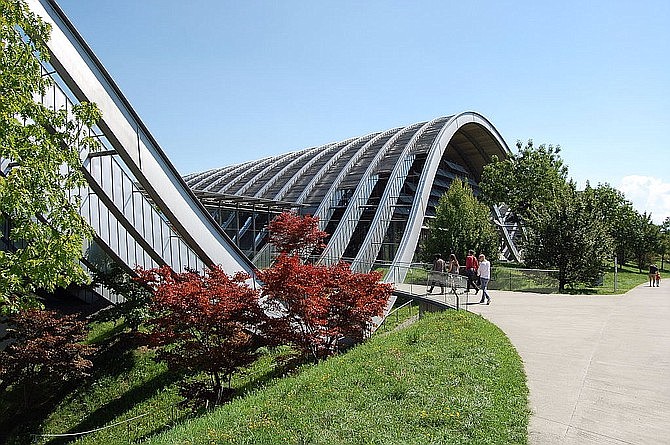
Even if they run the global financial system aground. In that case the state will hurry to save stock exchanges and banks. But it’s not stock exchange speculators and bankers who foot the bill. It’s the majority of employees… us, the middle class.” As Sanders runs for U.S. president, Bernie’s supporters may “feel the Bern”, but Tschäppät is Stadtpräsident (mayor) of Bern.
Of course, Switzerland’s capital city and environs offers more for visitors than, say, Bern’s municipal Department for Gender Equality. And Tschäppät isn’t the only famous Bernese reminiscent of Bernie - not only was Albert Einstein a fellow Jew, but he had an even wilder white hairdo. Infinite photos, film clips, original artifacts, documents and replicas regarding the physicist are at the Einstein Museum, in Bern’s History Museum.
Einstein lived in Bern for seven years, when the then-patent clerk worked out his groundbreaking Theory of Relativity.
Ironically, the museum celebrating the modern man who discovered E=mc 2 is inside a beautiful 1894-built castle inspired by 15th-century architecture. The apartment where Einstein lived from 1903–1905 is also open to the public at Kramgasse No. 49 in the Old Town, above what’s now a café (drinking its coffee raises your IQ!).
While Einstein may have been a lowly “technical expert third class” when working at the Swiss federal patent office, with its Art Nouveau panache, Bellevue Palace is first class. The picture-perfect vista from my balcony at this five-star has the elegance of physics. Across the Aare River flowing beneath my veranda, turrets of Bern’s History Museum puncture an emerald landscape punctuated by medieval-style homes with tiled rooftops and chimneys, with the Gurten mountain in the distance, a funicular ride away. To my left Kirchenfeldebrücke, an iron bridge traversed by trams, spans the Aare, while on the right is the domed 19th century-built Parliament House (Bundeshaus). There, free tours explain Switzerland’s multi-party system and initiatives proposed by ordinary citizens.
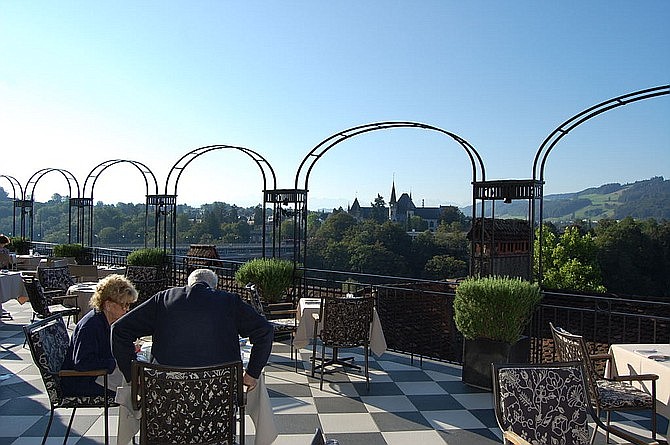
The exquisite view is also glimpsed from the Palace’s Bellevue Terrace, where sumptuous breakfast buffets are served. The grand hotel’s interior is appropriately grandiose, with Le Lobby’s orchids and illumined glass, mirrors and chandeliers, capped by the Gin-Gin Bar, featuring hundreds of sparkling bottles of gin - Beefeater, Tanqueray, Bombay, Gordon’s, etc. Switzerland’s government owns Bellevue Palace, located next door to Bundeshaus, where lawmakers from across the Alpine nation and visiting foreign leaders stay while in the capital - and the Gin-Gin comes in handy.
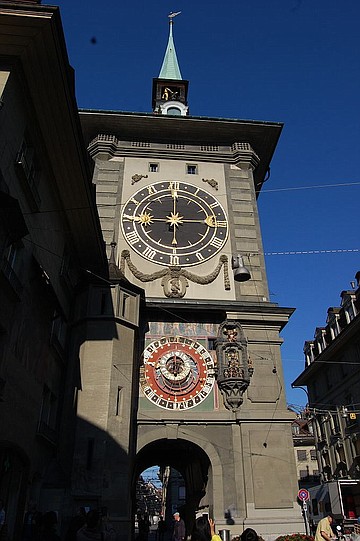
The Zytglogge, or “time bell,” is Swiss precision timing incarnate -an intricate, ornate, astronomical 1530-built Old Town clock. Perched atop a 13th century-constructed gate tower the clock features various zodiac and Biblical symbols, Roman mythological motifs, plus medieval figures - a knight on horseback, harlequin, etc. - and animals who, at the appointed moments, move and ring out the time. On the hour a gilded statue strikes the 3,100 pound bell. The hour hand on the western clock has a stylized sun and quarter moon on each end. The eastern clock face features large golden-colored Roman numerals to denote the hours.
Tower tours visit the clockworks’ innards and where women who slept with clergymen were jailed. The limestone and sandstone structure, stretching 179 feet from street to spire, is now above an arch trams pass through.
Elaborate statuary also crowns Old Town’s fountains, the strangest being the 1546 Kindlifresser, or “Child Eater.” This Swiss boogieman clutches and gobbles up children from atop a column encircled by standing bears near its base. A blue-robed, Ten Commandments-holding Moses is above another fountain across from Berner Münster. Begun in 1421, this gothic cathedral has painted, sculpted figurines depicting The Last Judgment, hellfire, devil and all, above the doorway, below gargoyles. The 330-foot spire holds a 10-ton-plus bell - Switzerland’s largest.
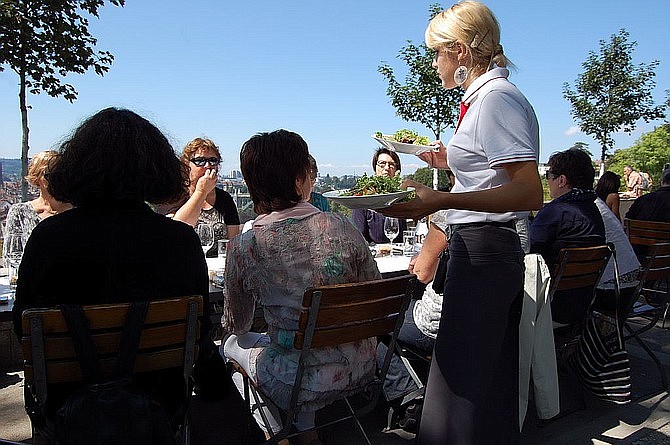
A UNESCO World Cultural Heritage site, Old Town’s streets are unique, with arcades and cellars built to shelter townsfolk during harsh winters, today housing boutiques and bistros. Crossing the Aare festooned with paddlers rowing rubber rafts on Nydeggbrücke bridge, climbing the hill bearing Restaurant Rosengarten, one sees exquisite Old Town is on a peninsula.
Surrounded by roses, Rosengarten offers fine Swiss and Mediterranean dining - and, in summer, arguably the finest panoramas of any Bern eatery. Although aptly named, 16 Gault-Millau points-winning Restaurant Terrasse, suspended just above the Aare’s rushing roar at the Bernese Riviera, is likewise spectacular.
Bern is much more than a blast from the medieval past - its futuristic Zentrum Paul Klee is an outpost of modernity. Klee was from the canton of Bern and the museum’s wavy gravy architecture perfectly complements his abstract art.
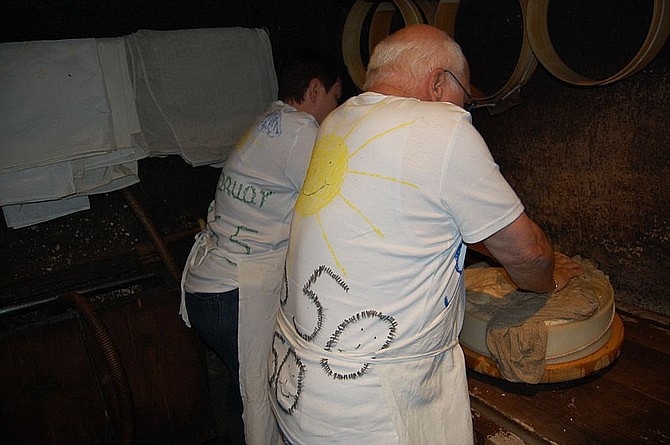
And what is Switzerland without Swiss cheese? Outside the city in the canton of Bern is Emmentaler Schaukäserei at Affoltern, which has cleverly expanded and opened up its production facility into a sort of working museum demonstrating how cheese is mass-produced and stored.
With cauldrons of boiling, molten cheese, it’s a cross between Macbeth’s first scene, assembly lines and artisans’ ceramics studios on a grand scale. With 300,000 visitors annually, Emmental Show Cheese Dairy is one of this small country’s most popular attractions, particularly with children.
Post-tour I embarked on a guided e-bike (app-based tours are available) odyssey off-the-beaten path on the Emmentaler Käseroute – or cheese route. Somewhere between motorcycles and bicycles, e-bikes’ small motors boost pedaling. Gliding, soaring through the Emmental outback on long and winding roads, up and down hills was great fun, but risky business: biker beware.
Bears gave Bern its name, and the Swiss capital’s heraldic animals are famously displayed at the Bear Park. Indeed, those socialists Bernie Sanders and Bern’s Mayor Tschäppät prefer Wall Street players to behave like bears, not bulls. In 1779, German poet Johann Wolfgang von Goethe called this city “the most beautiful that we have ever seen.”
You don’t have to be an Einstein to know this remains relatively true - or make a Faustian bargain with the devil to experience Bern, baby Bern!


Bernie Sanders attracts big campaign crowds with his authenticity and populism - but this unique candidate has met his match in unorthodox Alexander Tschäppät, Switzerland’s outspoken rabble-rouser.
Sanders is a Vermont Senator; Tschäppät has served in the Swiss parliament’s lower house. Sanders is a democratic socialist, Tschäppät belongs to Switzerland’s Social Democratic Party. Sanders rails against Wall Street, calls for breaking up big banks and taxing speculators, and champions the middle class.
Not to be outdone, in a 2015 May Day speech Tschäppät denounced “those who live off share trading and financial deals. They don’t work… They gamble for money [a]nd… with our jobs…. For them every day is a holiday.

Even if they run the global financial system aground. In that case the state will hurry to save stock exchanges and banks. But it’s not stock exchange speculators and bankers who foot the bill. It’s the majority of employees… us, the middle class.” As Sanders runs for U.S. president, Bernie’s supporters may “feel the Bern”, but Tschäppät is Stadtpräsident (mayor) of Bern.
Of course, Switzerland’s capital city and environs offers more for visitors than, say, Bern’s municipal Department for Gender Equality. And Tschäppät isn’t the only famous Bernese reminiscent of Bernie - not only was Albert Einstein a fellow Jew, but he had an even wilder white hairdo. Infinite photos, film clips, original artifacts, documents and replicas regarding the physicist are at the Einstein Museum, in Bern’s History Museum.
Einstein lived in Bern for seven years, when the then-patent clerk worked out his groundbreaking Theory of Relativity.
Ironically, the museum celebrating the modern man who discovered E=mc 2 is inside a beautiful 1894-built castle inspired by 15th-century architecture. The apartment where Einstein lived from 1903–1905 is also open to the public at Kramgasse No. 49 in the Old Town, above what’s now a café (drinking its coffee raises your IQ!).
While Einstein may have been a lowly “technical expert third class” when working at the Swiss federal patent office, with its Art Nouveau panache, Bellevue Palace is first class. The picture-perfect vista from my balcony at this five-star has the elegance of physics. Across the Aare River flowing beneath my veranda, turrets of Bern’s History Museum puncture an emerald landscape punctuated by medieval-style homes with tiled rooftops and chimneys, with the Gurten mountain in the distance, a funicular ride away. To my left Kirchenfeldebrücke, an iron bridge traversed by trams, spans the Aare, while on the right is the domed 19th century-built Parliament House (Bundeshaus). There, free tours explain Switzerland’s multi-party system and initiatives proposed by ordinary citizens.

The exquisite view is also glimpsed from the Palace’s Bellevue Terrace, where sumptuous breakfast buffets are served. The grand hotel’s interior is appropriately grandiose, with Le Lobby’s orchids and illumined glass, mirrors and chandeliers, capped by the Gin-Gin Bar, featuring hundreds of sparkling bottles of gin - Beefeater, Tanqueray, Bombay, Gordon’s, etc. Switzerland’s government owns Bellevue Palace, located next door to Bundeshaus, where lawmakers from across the Alpine nation and visiting foreign leaders stay while in the capital - and the Gin-Gin comes in handy.

The Zytglogge, or “time bell,” is Swiss precision timing incarnate -an intricate, ornate, astronomical 1530-built Old Town clock. Perched atop a 13th century-constructed gate tower the clock features various zodiac and Biblical symbols, Roman mythological motifs, plus medieval figures - a knight on horseback, harlequin, etc. - and animals who, at the appointed moments, move and ring out the time. On the hour a gilded statue strikes the 3,100 pound bell. The hour hand on the western clock has a stylized sun and quarter moon on each end. The eastern clock face features large golden-colored Roman numerals to denote the hours.
Tower tours visit the clockworks’ innards and where women who slept with clergymen were jailed. The limestone and sandstone structure, stretching 179 feet from street to spire, is now above an arch trams pass through.
Elaborate statuary also crowns Old Town’s fountains, the strangest being the 1546 Kindlifresser, or “Child Eater.” This Swiss boogieman clutches and gobbles up children from atop a column encircled by standing bears near its base. A blue-robed, Ten Commandments-holding Moses is above another fountain across from Berner Münster. Begun in 1421, this gothic cathedral has painted, sculpted figurines depicting The Last Judgment, hellfire, devil and all, above the doorway, below gargoyles. The 330-foot spire holds a 10-ton-plus bell - Switzerland’s largest.

A UNESCO World Cultural Heritage site, Old Town’s streets are unique, with arcades and cellars built to shelter townsfolk during harsh winters, today housing boutiques and bistros. Crossing the Aare festooned with paddlers rowing rubber rafts on Nydeggbrücke bridge, climbing the hill bearing Restaurant Rosengarten, one sees exquisite Old Town is on a peninsula.
Surrounded by roses, Rosengarten offers fine Swiss and Mediterranean dining - and, in summer, arguably the finest panoramas of any Bern eatery. Although aptly named, 16 Gault-Millau points-winning Restaurant Terrasse, suspended just above the Aare’s rushing roar at the Bernese Riviera, is likewise spectacular.
Bern is much more than a blast from the medieval past - its futuristic Zentrum Paul Klee is an outpost of modernity. Klee was from the canton of Bern and the museum’s wavy gravy architecture perfectly complements his abstract art.

And what is Switzerland without Swiss cheese? Outside the city in the canton of Bern is Emmentaler Schaukäserei at Affoltern, which has cleverly expanded and opened up its production facility into a sort of working museum demonstrating how cheese is mass-produced and stored.
With cauldrons of boiling, molten cheese, it’s a cross between Macbeth’s first scene, assembly lines and artisans’ ceramics studios on a grand scale. With 300,000 visitors annually, Emmental Show Cheese Dairy is one of this small country’s most popular attractions, particularly with children.
Post-tour I embarked on a guided e-bike (app-based tours are available) odyssey off-the-beaten path on the Emmentaler Käseroute – or cheese route. Somewhere between motorcycles and bicycles, e-bikes’ small motors boost pedaling. Gliding, soaring through the Emmental outback on long and winding roads, up and down hills was great fun, but risky business: biker beware.
Bears gave Bern its name, and the Swiss capital’s heraldic animals are famously displayed at the Bear Park. Indeed, those socialists Bernie Sanders and Bern’s Mayor Tschäppät prefer Wall Street players to behave like bears, not bulls. In 1779, German poet Johann Wolfgang von Goethe called this city “the most beautiful that we have ever seen.”
You don’t have to be an Einstein to know this remains relatively true - or make a Faustian bargain with the devil to experience Bern, baby Bern!
Comments